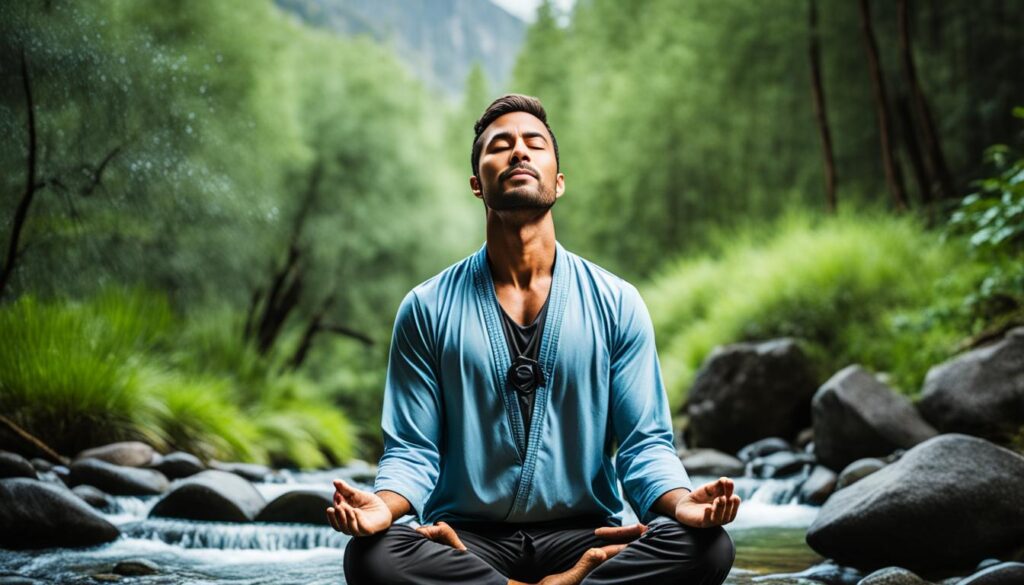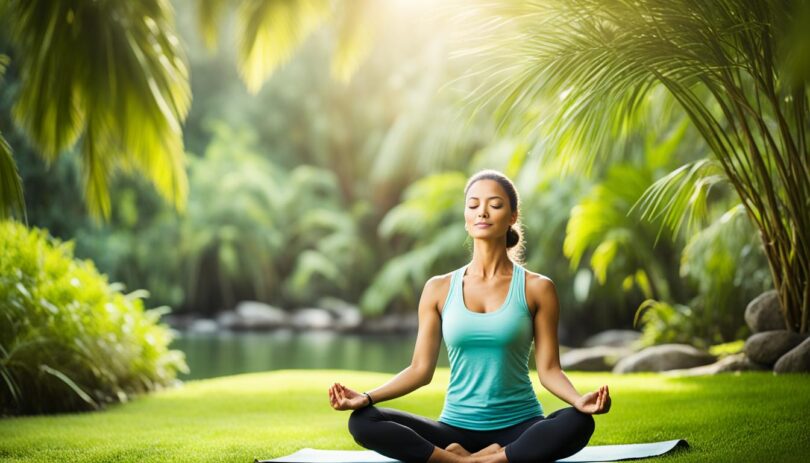Welcome to our exploration of yoga and meditation and their incredible ability to help you harness the power of mindfulness in your life. With the busy and hectic pace of modern life, it can be easy to get caught up in stress, anxiety, and other negative thoughts and emotions. But by incorporating yoga and meditation into your routine, you can learn to quiet the mind, reduce stress, and develop a deeper connection to yourself and the world around you.
Key Takeaways:
- The practice of yoga and meditation can help you cultivate mindfulness in your daily life.
- Through yoga and meditation, you can reduce stress, quiet the mind, and improve overall well-being.
- Yoga poses and mindful breathing techniques can deepen your meditation practice and foster emotional and mental balance.
- Conscious breathing techniques can deepen your mindfulness practice and bring about a state of calm and focus.
- By incorporating mindfulness techniques into your everyday activities, you can cultivate a more present and fulfilling life.
Understanding Mindfulness and its Benefits
Mindfulness is a practice that involves paying attention to the present moment with open-mindedness and curiosity. Through cultivating mindfulness, we can become more aware of our thoughts, feelings, and bodily sensations, allowing us to be more present and engaged in our daily lives.
Research has shown that incorporating mindfulness practices in your daily routine can have numerous benefits for your mental health and overall well-being. Regular practice of mindfulness meditation can reduce symptoms of anxiety and depression, increase feelings of calmness and peace, and improve cognitive function.
The benefits of meditation are not limited to mental health. Cultivating mindfulness through meditation can also have physical health benefits, such as improving sleep quality, lowering blood pressure, and reducing inflammation.

The Benefits of Cultivating Mindfulness
| Benefit | Explanation |
|---|---|
| Improved mental health | Mindfulness has been shown to reduce symptoms of anxiety and depression, and increase feelings of well-being |
| Enhanced cognitive function | Mindfulness meditation has been found to improve attention, memory, and decision-making abilities |
| Better sleep quality | Mindfulness practices can help improve the quality of your sleep by reducing stress and promoting relaxation |
| Reduced stress levels | Mindfulness can help you manage stress more effectively by increasing your ability to regulate your emotions |
| Lowered blood pressure | Research has found that regular meditation practice can lead to reductions in blood pressure |
Through cultivating mindfulness, we can lead more fulfilling lives, free from the distractions and stressors that can preoccupy our minds. By incorporating simple mindfulness practices into our daily routines, we can improve our mental and physical health, promote greater well-being, and enhance our overall quality of life.
Exploring the Connection between Yoga and Mindfulness
Yoga and meditation have a symbiotic relationship that helps harness the power of mindfulness. The practice of yoga poses, also known as asanas, improves not only physical health but also helps calm and focus the mind. It offers an opportunity to connect with the body and be present in the moment, an essential aspect of mindfulness.
Yoga for mental health advocates that incorporating mindfulness into yoga amplifies its potential to improve emotional balance and mental well-being. Mindful breathing techniques practiced during yoga enhance one’s self-awareness and promote a state of calm.
Yoga poses can be specifically geared towards enhancing mindfulness. Tree pose, for example, stresses the importance of grounding the feet on the ground, focusing the mind on balance and stability. This helps center the mind, bringing awareness to the present and calming the mind’s chatter. Shavasana, or corpse pose, is another popular asana that helps with total relaxation and the idea of letting go.

The benefits of practicing yoga and mindfulness are far-reaching. Incorporating them into your daily routine can foster emotional and mental balance while improving physical health and overall well-being.
The Science Behind Mindfulness and Meditation
Mindfulness and meditation have been shown to have numerous benefits for mental well-being. But what exactly is the science behind this?
Studies have found that regular meditation practice can lead to structural changes in the brain, such as increased gray matter in areas associated with emotion regulation, self-awareness, and memory. Additionally, mindfulness meditation has been shown to reduce activity in the amygdala, the part of the brain responsible for the fight-or-flight response, indicating a reduction in stress response.
One study published in the Journal of the American Medical Association found that mindfulness meditation can be as effective as antidepressant medication for reducing symptoms of depression and anxiety. Meditation has also been found to reduce symptoms of PTSD, improve sleep quality, and enhance focus and cognitive function.
“Meditation is not a means to an end. It is both the means and the end.” -Jiddu Krishnamurti
The benefits of mindfulness and meditation aren’t just limited to the brain. Research has shown that these practices can have positive effects on the body as well. For example, studies have found that meditation can lower blood pressure and reduce inflammation throughout the body, which can help prevent chronic health conditions such as heart disease, diabetes, and certain types of cancer.
Types of Meditation
There are many different types of meditation, each with their own unique benefits and techniques. Some common types include:
- Mindfulness meditation: focuses on present-moment awareness and non-judgmental observation of thoughts and sensations
- Transcendental meditation: involves the repetition of a mantra to quiet the mind and promote relaxation
- Loving-kindness meditation: cultivates feelings of love, kindness, and compassion towards oneself and others
It’s important to find a type of meditation that resonates with you and fits your personality and lifestyle.
Meditation Techniques
Some common meditation techniques include:
- Guided meditation: involves listening to a teacher or recording, who provides verbal guidance to help you stay focused and relaxed
- Body scan meditation: involves focusing your attention on different parts of your body, relaxing each one in turn
- Visualization meditation: involves creating mental images to promote feelings of relaxation and positivity
Whichever technique you choose, it’s important to practice regularly in order to experience the benefits of mindfulness and meditation.

Developing a Mindful Meditation Practice
If you’re new to meditation, starting a regular practice can be daunting. However, by following some simple steps, you can establish a routine that will help you cultivate mindfulness and bring balance to your daily life.
Choose a Quiet and Comfortable Space
Find a serene and quiet space without distractions to practice your meditation. Whether it’s a corner of your bedroom or a dedicated meditation area, ensure that your space is clean, welcoming, and comfortable. Sit on a cushion or a yoga mat, and keep your back straight but not rigid.
Set an Intention
Before you begin your practice, set an intention in your mind. It can be a specific focus for the session or a general feeling of peace and calm. Allow yourself to feel present and open to the experience.
Focus on Your Breath
Your breath is your anchor for the meditation practice. Pay attention to its rhythm and depth, and try to keep your attention on your breath for the duration of your session. You can count your breaths or focus on the sensation of the air moving in and out of your nostrils.
Try Different Techniques
There are many meditation techniques to choose from, including loving-kindness meditation, body scan, and breath awareness. Experiment to find the ones that work best for you and your goals.
| Technique | Description |
|---|---|
| Loving-kindness Meditation | A practice that cultivates feelings of love and compassion towards oneself and others. |
| Body Scan | A technique that involves bringing awareness to each part of the body, releasing tension and promoting relaxation. |
| Breath Awareness | A practice that involves focusing on the breath and observing its flow in and out of the body. |
Be Patient and Consistent
Meditation is a skill that requires practice and patience. Start with shorter sessions and gradually increase the duration. Stay committed and consistent, even if you feel like you’re not making progress. Recognize that each session is an opportunity for growth and development.
By implementing these tips and techniques, you can develop a mindful meditation practice that promotes relaxation, focus, and well-being. Remember to stay open-minded and gentle with yourself throughout the process.

Yoga as a Path to Inner Peace
Yoga provides a holistic approach to physical, emotional, and mental wellness. It is not just a physical exercise but also a spiritual practice. Practicing yoga regularly can help you find inner peace and tranquility, increasing your overall well-being and fostering mindfulness.
Yoga is an effective way to reduce stress levels and anxiety, two aspects that can have a profound impact on your mental health. By practicing yoga for mental health, you can achieve a state of calm and balance. Moreover, yoga can help you develop a deeper connection between your mind, body, and spirit, working towards overall wellness.
Besides, practicing yoga can increase flexibility, lower blood pressure, and reduce the risk of heart disease. Incorporating yoga with meditation techniques can further enhance its benefits. The benefits of meditation, such as cultivating mindfulness, can be achieved by practicing yoga, especially with poses emphasizing inward focus.

Practicing yoga cultivates a sense of self-awareness that can help you respond better to stressors in life. Your ability to stay present in challenging situations improves, allowing for more objective thinking. Asana and meditation feeding each other, working towards finding inner stillness, generates overall well-being.
Table: Benefits of Yoga for Mental Health
| Benefits | Explanation |
|---|---|
| Reduces stress and anxiety levels | Yoga stimulates the parasympathetic nervous system, the “rest and digest” system to reduce stress levels. It also helps alleviate anxiety symptoms, including intrusive thoughts, worries, and panic attacks |
| Increases emotional well-being | Yoga can help improve your mood, decrease negative emotions, and promote feelings of happiness and self-worth |
| Enhances mental clarity | The practice of asana and meditation sharpens focus and improves concentration, leading to increased mental clarity and awareness |
| Promotes better sleep | Yoga can help you relax and unwind, leading to improved sleep quality and better sleep patterns |
By practicing yoga for mental health, you can enjoy these benefits and more, making it a valuable addition to your daily routine.
The Role of Breath in Yoga and Meditation
In both yoga and meditation practices, the breath plays a crucial role in cultivating mindfulness. Breathing is a natural process that we often take for granted, but with conscious breathing techniques, we can deepen our meditation practice and bring about a state of calm and focus.
The breath is intimately connected with emotional states and can be used as an anchor to bring us back to the present moment. By slowing down and observing our breath, we can become more aware of our thoughts and bodily sensations, cultivating mindfulness in our daily lives.
In yoga, breath control techniques, or pranayama, are used to influence the flow of prana, or life force energy, through the body. By regulating our breath, we can calm the mind and prepare the body for deeper states of meditation.
The most basic pranayama technique is called ujjayi, or “victorious breath.” This technique involves breathing through the nose while constricting the muscles at the back of the throat. This creates a gentle hissing sound, and the breath becomes slower and deeper.
A more advanced technique is kapalabhati, or “skull-shining breath.” This is a rapid, forceful exhale through the nose, followed by a passive inhale. This technique is used to energize and purify the body and mind.

Mindful Breathing Exercise
Try this simple breathing exercise to cultivate mindfulness:
- Sit upright in a comfortable position with your eyes closed.
- Take a deep inhale through your nose, counting to four.
- Hold your breath for a count of four.
- Exhale slowly through your mouth, counting to four.
- Hold your breath for a count of four.
- Repeat this cycle for several minutes, focusing your attention on the sensation of your breath.
“The present moment is filled with joy and happiness. If you are attentive, you will see it.”
– Thich Nhat Hanh
By paying attention to our breath and being present in the moment, we can cultivate mindfulness and bring greater peace and clarity into our lives.
Incorporating Mindfulness into Daily Life
Practicing mindfulness isn’t just about meditation. It’s about bringing that same level of present moment awareness to every aspect of your daily life. Incorporating mindfulness techniques into your work, relationships, and self-care routine can help cultivate a more present and fulfilling life.
Mindfulness at Work
At work, we often find ourselves multitasking and feeling overwhelmed by our to-do lists. Incorporating mindfulness breaks can help reduce stress and increase productivity. Try taking a few minutes every hour to focus on your breath or take a mindful walk around the office.
“Mindfulness is a way of befriending ourselves and our experience.” – Jon Kabat-Zinn
Mindful Relationships
In our relationships, we often find ourselves distracted by our phones or lost in our own thoughts. Practicing mindful communication can improve our connections with others. When talking to someone, try to give them your full attention and truly listen to what they’re saying.
Mindful Self-Care
Self-care is essential for our mental and physical well-being. Incorporating mindfulness practices such as yoga and meditation can help reduce stress and anxiety. Set aside time in your schedule for self-care activities and make them a priority.

By incorporating mindfulness into your daily life, you can cultivate a greater sense of awareness and presence. Take some time to reflect on where you can integrate mindfulness into your routine and start reaping the benefits of a more present and fulfilling life.
The Mind-Body Connection in Yoga and Meditation
Yoga and meditation are two powerful practices that have a profound effect on the mind and body. When practiced together, they can harness the power of mindfulness to promote overall health and well-being.
Research has shown that the mind-body connection is not just a metaphor, but a tangible phenomenon that occurs during yoga and meditation. By bringing awareness and attention to the present moment, these practices can reduce stress and promote physical healing.
Meditation is known to trigger the body’s relaxation response, which helps calm the mind and reduce tension in the muscles. As you focus on your breath and become more present in the moment, your body responds by lowering your heart rate and blood pressure. This state of relaxation allows your body to heal and rejuvenate, leading to increased vitality and energy.
Similarly, practicing yoga can have a positive impact on both the mind and body. Yoga is a mind-body practice that combines physical postures, breathing techniques, and meditation to promote relaxation and reduce stress. By practicing yoga regularly, you can improve flexibility, strength, and balance, while also reducing anxiety and depression.
Together, yoga and meditation can enhance the mind-body connection and promote overall wellness. By incorporating these practices into your daily routine, you can experience increased physical health, reduced stress, and a deeper connection with yourself and the world around you.
The Benefits of Yoga and Meditation for Mental Health
| Benefit | Yoga | Meditation |
|---|---|---|
| Reduces Symptoms of Anxiety and Depression | ✓ | ✓ |
| Improves Focus and Attention | ✓ | ✓ |
| Increases Emotional Resilience | ✓ | ✓ |
| Promotes Relaxation and Reduces Stress | ✓ | ✓ |
| Enhances Overall Well-Being | ✓ | ✓ |
By practicing yoga and meditation, you can cultivate mindfulness and harness the power of your mind-body connection, leading to improved mental health and overall well-being.
Nurturing Your Well-Being through Yoga and Meditation
Yoga and meditation have the power to nurture your overall well-being, both mentally and physically. Through the practice of yoga, you can achieve a sense of inner peace and balance, while meditation can help reduce stress and anxiety.
The benefits of yoga and meditation are numerous, including improved flexibility and strength, reduced blood pressure, and increased feelings of happiness and well-being. By practicing yoga poses for mindfulness, you can cultivate greater awareness, presence, and resilience in your daily life.
One of the key benefits of yoga and meditation is that they can help improve emotional balance. By practicing mindful breathing and movement, you can learn to manage your emotions more effectively and reduce feelings of overwhelm or anxiety. This can be especially helpful in relieving symptoms of depression or other mood disorders.
Benefits of Meditation for Mental Health
| Benefit | Description |
|---|---|
| Reduces Stress | Meditation has been shown to lower the levels of stress hormones in the body, leading to reduced levels of stress and anxiety. |
| Improves Focus | Regular meditation can improve attention and concentration, helping to increase productivity and focus. |
| Enhances Self-Awareness | Through meditation, you can develop a greater sense of self-awareness and understanding of your own thoughts and emotions. |
| Promotes Emotional Health | Research has shown that meditation can increase positive emotions and reduce symptoms of depression and anxiety. |
Overall, the benefits of yoga and meditation can help you achieve greater wellness through body and mind. By incorporating these practices into your daily routine, you can cultivate greater mental and physical balance, improve emotional well-being, and enhance your overall quality of life.
Conclusion
Congratulations on taking the first step to harnessing the power of mindfulness through yoga and meditation. By dedicating time to these practices, you have the opportunity to develop a deeper connection with yourself and live a more fulfilling life.
Remember that mindfulness is not a destination, but a journey. It requires consistent effort and practice to cultivate a state of presence and inner peace.
As you continue on this journey, be patient with yourself and allow yourself to experience the full range of emotions that come with it. With time and practice, you will begin to experience the transformative effects of mindfulness on your mental health and overall well-being.
So, keep showing up to the mat. Keep carving out time for meditation in your daily routine. And most importantly, keep an open mind and an open heart as you continue to explore the infinite possibilities that come with harnessing the power of mindfulness.
FAQ
What is mindfulness?
Mindfulness is the practice of bringing awareness to the present moment without judgment. It involves paying attention to thoughts, feelings, and bodily sensations, helping to cultivate a sense of clarity, calm, and non-reactivity.
What are the benefits of meditation?
Meditation has numerous benefits, including reducing stress, anxiety, and depression, improving focus and concentration, increasing self-awareness, promoting emotional well-being, and fostering a greater sense of overall peace and contentment.
How does yoga contribute to mental health?
Yoga is a holistic practice that combines physical postures, breathwork, and meditation. Through its mindful movements and deep breathing techniques, yoga helps reduce stress, calm the mind, improve cognitive function, and promote mental well-being.
Can specific yoga poses enhance mindfulness?
Yes, certain yoga poses can deepen mindfulness by encouraging focused attention and body awareness. Poses like Tree Pose (Vrksasana), Warrior II (Virabhadrasana II), and Child’s Pose (Balasana) are known to promote grounding, presence, and a sense of calm.
What are some meditation techniques for beginners?
For beginners, it’s helpful to start with simple breath-focused meditation, where you bring attention to the sensation of the breath entering and leaving the body. Guided meditations, body scan meditations, and loving-kindness meditations are also great options to begin your practice.
How can mindfulness be integrated into daily life?
Mindfulness can be incorporated into daily life by practicing simple acts of mindfulness such as mindful eating, mindful walking, and mindful listening. Taking moments throughout the day to pause, breathe, and fully engage in the present moment can greatly enhance your overall sense of well-being.
What is the connection between breath and mindfulness?
Breath is a central component of mindfulness practices. Focusing on the breath helps anchor attention to the present moment, as it is constantly available and acts as an anchor for the wandering mind. Conscious breathing techniques can calm the nervous system and increase mindfulness.
How does yoga nurture overall well-being?
Yoga nurtures overall well-being by promoting physical strength, flexibility, and balance, reducing stress, cultivating self-compassion, and fostering a sense of inner peace. It supports the mind-body connection and encourages individuals to listen to their bodies and prioritize self-care.
Can mindfulness and meditation contribute to improved relationships?
Yes, mindfulness and meditation can contribute to improved relationships by enhancing self-awareness and empathy. As individuals become more present and emotionally balanced, they can communicate more effectively, develop deeper connections, and respond to challenges with greater compassion and understanding.
How long does it take to experience the benefits of mindfulness and meditation?
The benefits of mindfulness and meditation can vary from person to person. Some individuals may experience immediate effects, such as feeling calmer and more focused after a single session. However, consistent practice over time generally leads to more profound and lasting benefits.


Leave a Comment